Dome of the Rock
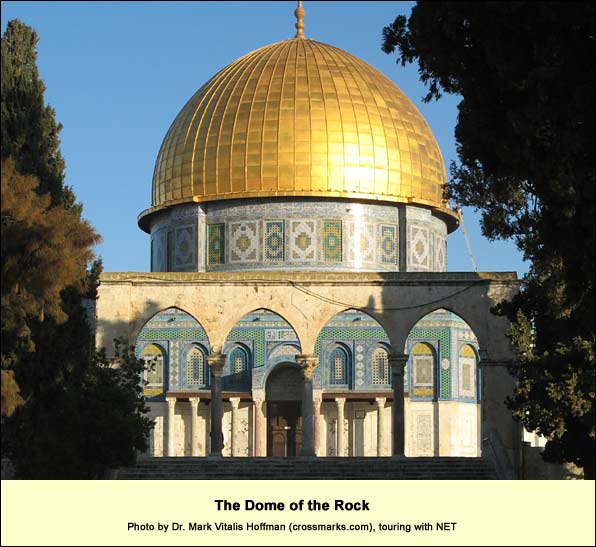
In the expanse around it, smaller domes stand like planets caught in eternal stillness: the Dome of the ChainA contemporary of the Dome of the Rock, the Dome of the Chain received its name from local legend: in the time of Solomon's Temple, a chain hung from heaven here. Anyone who had to bear witness would grasp it, and if he lied, a link would break off. The spatial relation between this dome and that of the Rock is tantalizingly like the relation between the altar of sacrifice and the Temple building, containing the Holy of Holies. to its east, or the Dome of the Spirits to its north, and the black (formerly silver) dome of the al-Aqsa Mosque on the southern end. (See the next picture.) For many visitors from the West, this will be the first time they enter a sacred precinct that is open to the sky. There is the vast and tranquil space, the sudden quiet. "The world is too much with us," wrote William Wordsworth, "Late and soon. Getting and spending, we lay waste our powers." Here is a space to re-collect one's powers. An approximation of heaven. No doubt it made this impression in earlier ages too, when it was the Temple Mount. But because it is still the Temple Mount for Jews, although the Noble Sanctuary for Muslims, it remains the most politically sensitive spot on earth.
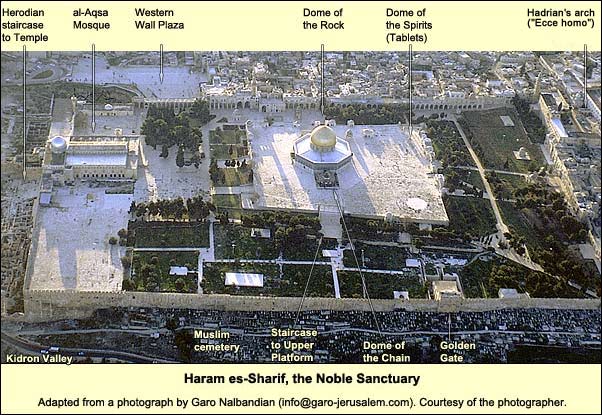
The Koran (Quran) mentions the twofold destruction of the Temple. It also tells us that while in Medina, Muhammad changed the qiblahThe direction of Muslim prayer, indicated in a mosque by the mihrab, a niche or alcove. from Jerusalem to Mecca. Originally, that is, he prayed in the same direction as the Jews, who formed a large congregation in Medina. Thus the Muslims knew about the Temple, although it had disappeared almost 500 years before the birth of Islam. The chief name for Jerusalem among their early historians was "the Holy House." This was later shortened to the present designation, "the Holy" (al-Quds). It is not surprising, then, that when the Muslims conquered Jerusalem in 638 AD under the CaliphCaliph: from the Arabic khalifa, meaning "successor" (of Muhammad the Prophet); hence: the leader of Islam. Omar, they reverently cleaned the area and erected a mosque. This was "near the eastern wall," wrote ArculfA Gallic bishop with a strong interest in architecture. He visited the holy land around 680 AD, bringing back sketches of buildings and descriptions of landscape. around 680 (he probably meant the eastern wall of the city, because we have evidenceMax Kuechler, Jerusalem: Ein Handbuch und Studienreisefuehrer zur Heiligen Stadt, 2., vollständig überarbeitete Auflage, Goettingen: Vandenhoeck & Ruprecht, 2014), pp. 179-184.that this mosque was built of stone on the southern end of the platform by 640 AD). Eight years later the Umayyad Caliph Abd al-Malik began to erect the Dome of the Rock, which he finished in 691. The original building has survived (except for the dome, replaced in 1022, and some of the decoration). No one does archaeology near the Dome. MaimonidesMoses Maimonides, 12th-century rabbi, commentator, legist, philosopher and physician. His Guide for the Perplexed attempted to reconcile Aristotle with Jewish teachings. Under Greek influence, he formulated the Thirteen Principles of Judaism, a faith which had earlier tolerated no creedal statements in the form of dogma. He was court physician to Saladin. His grave (the best-attested famous grave in the land) is in Tiberias. Of Maimonides it is said among Jews, "From Moses until Moses, there was no one like Moses." reported that King Josiah hid the Ark of the Covenant below the Temple (The Book of Temple Service, 17), yet earlier sources say nothing of this. It is doubtful whether a dig would turn up much: if the Romans didn't level the area, later builders surely did. Despite the lack of definitive evidence, however, most scholars accept the place of the Dome as that where the Temple stood. How would the Muslims have known that this was the holy place? The decisive factor was probably the prominent outcropping of bedrock called the sakhra in Arabic: no other spot on the mountain could compete with it for numinous power. (Enlarging the photo, however, we see the effects of Crusader quarrying.) Another factor may have played a part: in the decades between the Muslim conquest and the building of the dome in 691, Jews were again permitted to pray on the Mount, and they focused on "the pierced stone" (note the hole in the photo). As to al-Malik's motive in building the Dome, the founder's inscription offers a clue. We can see this upon entering. Piers and pillars divide the area around the rock into two "ambulatories," outer and inner. These eight dividing piers and sixteen pillars support arches, above which is a band of writing. It runs on both sides of the arcade for a total of 240 meters. Apart from giving credit to the builder and telling us the date, it contains a citation from the Koran (Qur'an), Sura 4, verse 171 (here Jesus is called Isa and Mary Marium): O followers of the Book! do not exceed the limits in your religion, and do not speak (lies) against Allah, but (speak) the truth; the Messiah, Isa son of Marium is only an apostle of Allah and His Word which He communicated to Marium and a spirit from Him; believe therefore in Allah and His apostles, and say not, Three. Desist, it is better for you; Allah is only one God; far be It from His glory that He should have a son. Whatever is in the heavens and whatever is in the earth is His, and Allah is sufficient for a Protector.
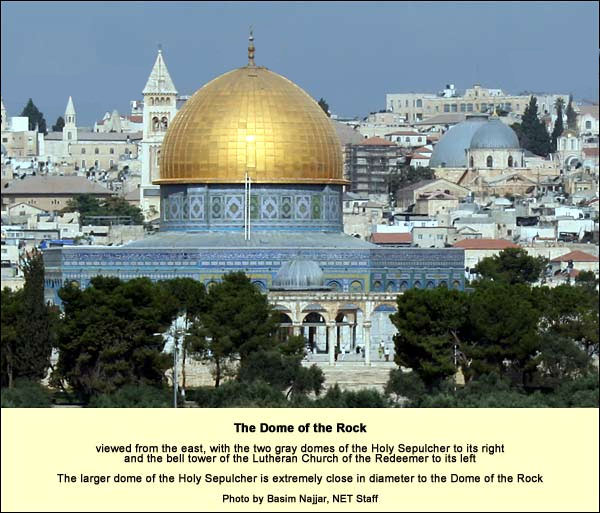
This shows one of al-Malik's motives. The Koran had laid on Muslims the religious duty of striving (jihad) to bring Islam to the world. The only serious rival was Christianity. Here the Muslims had taken over a Christian city with many beautiful churches, among them the (then) magnificent Church of the Resurrection (now called the Holy Sepulcher). In the words of a 10th-century Muslim historian who lived in Jerusalem: Caliph Abd al-Malik, noting the greatness of the Dome of the Holy Sepulcher and its magnificence, was moved lest it should dazzle the minds of Muslims and so erected, above the Rock, the Dome which is now seen there. (MuqaddasiMuqaddasi. Al-Muqaddasi. Description of Syria, including Palestine. Translated by G. Le Strange. Palestine Pilgrims Text Society 3. New York: AMS Press, 1971., pp. 22-23 ) (Many say that al-Malik had a political rival in Mecca: he built the Dome so that his subjects would pilgrim to Jerusalem, rather than make the obligatory haj. If so, that would have been heresy, but the notion is suspect. Its earliest source is a 9th-century Abbasid historian, Yaqubi. No other contemporary or near-contemporary historian mentions it. Furthermore, Yaqubi may have been biased: the Abbasids were interested in discrediting the Umayyad caliphs. One of them even substituted his own name for al-Malik's in the founding inscription of the Dome of the Rock, but forgot to change the date.) Murphy-O'ConnorMurphy-O'Connor, Jerome. The Holy Land: An Archaeological Guide, 4th edition. London: Oxford, 1998. (p.86) suggests an additional motive. By its splendor, we have seen, this Muslim-funded building was to outshine the Christian Holy Sepulcher. By its place, it would present Islam as God's more perfect successor to Judaism. In Muslim belief, Islam completes and perfects the truths of both its monotheistic forebears. The embodiment of this fulfillment is the Dome of the Rock. That makes sense, and yet -- in that case, why not erect a specifically Islamic building? In those days that would have meant a mosque for congregational prayer, to replace the modest wooden one that Arculf saw in 680. The Dome of the Rock, an octagon, will not do for a congregation. Rather, it closely resembles contemporary octagonal churches of Christendom: for example, that over Peter's House in Capernaum, the Church of Mary on Mt. Gerizim, and the portion of the Holy Sepulcher around the grave of Jesus. The dome of the last was 20.46 meters in diameter, that of the Muslim shrine 20.44: a one-inch difference. The octagonal church in Christendom, not built for a congregation, typically commemorates an event or honors a saint. Instead of erecting a mosque on the rock, al-Malik put up this shrine. Was he commemorating something? In the minds and hearts of Muslims, the Dome of the Rock does have a specifically Islamic significance, and perhaps it already had it then. Muslims believe that Muhammad ascended to heaven from here. The first verse of Sura 17 in the Koran states: "Glory be to Him who carried His servant by night from the holy shrine to the distant shrine (al-masjid al-aqsa) the precincts of which We have blessed, that We might show him some of our (miraculous) signs." (This verse appears on the drum outside. The tiling, redone in the 20th century, copied the 16th-century repairs of the Turkish Sultan Suleiman the Magnificent. He too may have copied an inscription that was already there.) A number of early Muslims, connecting the prophet's night journey with his ascension (Koran, Sura 53: 4-10) understood the distant (al-aqsa) shrine to be heaven. By the 8th century, though, most Muslim scholars were already interpreting the holy shrine as Mecca and the distant one as Jerusalem. (PetersPeters, F.E. Jerusalem. Princeton: Princeton University Press, 1985., pp. 182-184.) Since they associated the night journey with the ascension, they conceived that the prophet first journeyed to Jerusalem and from here ascended. The 8th-century Life of the Prophet reports that he made the 40-day journey in a single night on the back of a white winged beast, half mule, half donkey. The outcropping of bedrock (al-sakhra) at some stage came to be identified as the place from which Muhammad ascended. The small reliquary above the southwest corner of the rock is believed to contain a hair of the prophet's head. It also shelters his footprint in the rock, which a visitor may touch if invited to do so by a Muslim. The rock, according to a medieval legend, wanted to ascend with Muhammad (resulting in the opening of the cave on the south end), but the Angel Gabriel held it down. The angel's fingerprints are visible on the western edge, just north of the reliquary. These were probably the very marks that Christians saw as stemming from the hobnails on the boots of the soldiers who killed Zechariah.
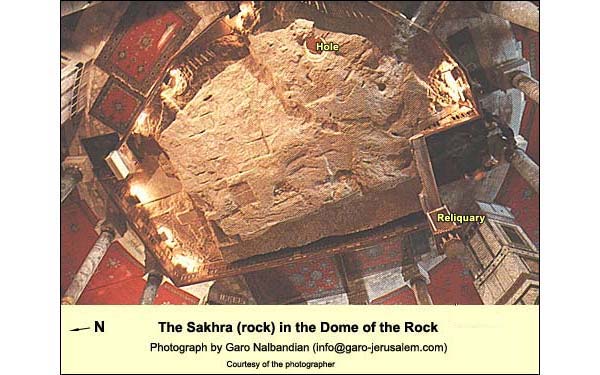
In 688 AD, Islamic traditions were still in flux. Muslim historians were careful to cite their sources and voice their doubts. The Caliph al-Malik may have known the account linking Jerusalem with the Prophet's ascent. If so, the Dome of the Rock would have played a part in solidifying the version of tradition it commemorated. Murphy-O'ConnorMurphy-O'Connor, Jerome. The Holy Land: An Archaeological Guide, 4th edition. London: Oxford, 1998. (p.90) points out another dome, a few yards to the northwest, called the Dome of the Ascension. An inscription on it dates it to 1200 AD. The name is proof, he says, that the larger and older building could not have been intended to commemorate this event. Yet the tradition of Muhammad's ascent from Jerusalem was in place before the Crusaders arrived. Surely, the spot must already have been located. There is, besides, another way of explaining this little dome: its plan brings to mind a Crusader baptistery, and the nearby Dome of the Rock, when it functioned as a Crusader church, would have needed one. On taking the baptistery from the Crusaders, adapting it, and adding the inscription, the Muslims connected it to the Dome of the Rock by saying that here Muhammad prayed before ascending. The belief that Muhammad ascended from Jerusalem has made al-Quds the third holiest place in Islam, after Mecca and Medina. This tradition attracted others: the rock is the center of the world; it is supported by a palm tree growing out of the river of paradise; Islam's holiest shrine, the qa'baAlso "Kaaba." A shrine in Mecca enclosing a black stone (a meteor), said to have been given by the angel Gabriel to Abraham. in Mecca, will be transported here on Judgment Day, and God will set his throne on the rock to judge. The souls of the dead await this day in the cave on the rock's southern edge. Traditions apart, the interior contains the secret of all great art: it combines wildness and form without compromising either. The splendor of the mosaics tends toward the infinite, every inch packed with design: one feels there could be no more. All this goes on in strict observance of the ban on graven images.
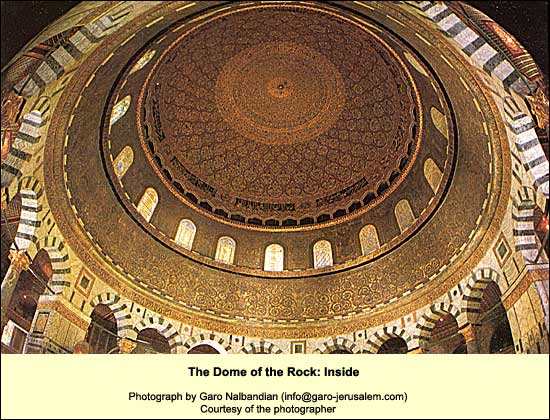
{mospagebreak title=Chronology} A Brief Chronology of the Temple Mount, the Muslim Noble Sanctuary Time unknown. The near-sacrifice of Isaac occurs on the "Mountain of the Lord" (Genesis 22:11-14The angel of Yahweh called to him out of the sky, and said, “Abraham, Abraham!”He said, “Here I am.” He said, “Don’t lay your hand on the boy, neither do anything to him. For now I know that you fear God, since you have not withheld your son, your only son, from me.” Abraham lifted up his eyes, and looked, and saw that behind him was a ram caught in the thicket by his horns. Abraham went and took the ram, and offered him up for a burnt offering instead of his son. Abraham called the name of that place Yahweh Will Provide. As it is said to this day, “On Yahweh’s mountain, it will be provided.”). 4000 years ago: On a lower spur of this hill, to the south, is the city of Jerusalem. About 3000 years ago, David conquers the city from the Jebusites. Later he goes "up" and buys the threshing floor of Arauna the Jebusite, erecting a sacrificial altar (2 Samuel 24:24 The king said to Araunah, “No; but I will most certainly buy it from you for a price. I will not offer burnt offerings to Yahweh my God which cost me nothing.” So David bought the threshing floor and the oxen for fifty shekels of silver.). Chronicles 22:1 says the place was here. Around 960 BC, Solomon builds the Temple. In 586 BC, the Babylonians destroy it and exile the people of Judah. In 538 BC, having conquered Babylon, Cyrus of Persia allows exiles to return home. Among them are some of the exiled Jews. From 520 until 515 BC, the Jews build a second Temple, modest compared to its predecessor. In 167 BC, the Seleucids, a faction of the Greek empire, desecrate the Temple by sacrificing a pig on the altar. Three years later the Maccabees retake Jerusalem and re-dedicate the Temple. Jews celebrate this event at Hanukah, Hebrew for "dedication." Around 20 BC, HerodHerod ruled the land under Roman auspices from 37 - 4 BC. After his death, the Romans called him "the Great" because of his building activities. Christians chiefly remember him, however, as the killer of the innocent children (Mt. 2: 16). gets the consent of the priests to tear down the Temple and rebuild it on a grander scale. He finishes most of it within eight years, although work continues until 63 AD. This is still called the Second Temple. In 70 AD, having put down the Jewish revolt, the Romans destroy the Temple. In 135 AD, having put down the second major Jewish revolt in the land, the Emperor Hadrian bans Jews from the city and renames the latter "Aelia Capitolina." One ancient historian, Dio Cassius, implies that he erected a temple to Jupiter here, but the text could mean only that he built this temple somewhere in Jerusalem to replace the Jewish one as a religious focus. Centuries of neglect. In 333 AD, the Bordeaux Pilgrim records seeing a rock where the altar had been. This rock has a hole in it, and here the Jews weep annually over the destruction of the Temple. Nearby he sees two statues of Hadrian. In 638 AD, the Muslims conquer Jerusalem, clean up the mount, and erect a wooden mosque near the eastern wall. From 688 to 691 AD, the Caliph Abd al-Malik builds the Dome of the Rock. He may already have the tradition that this mountain was the "distant" (Arabic: aqsa) sanctuary mentioned in the Koran, to which Muhammad journeyed by night from the Great Mosque in Mecca. The Koran also speaks of Muhammad's ascension into heaven to receive instruction from God. Muslims connect this account to the night journey: from here, they believe, he ascended. Around 711 AD, al-Malik's son and successor, al-Walid, builds the al-Aqsa mosque on the southern end. The whole area is now known as Haram es-Sharif (the Noble Sanctuary). It is the third holiest site in Islam, a focus of pilgrimage. In 1099 the Crusaders capture Jerusalem. They rename al-Aqsa "the Temple of Solomon" and the Dome of the Rock "the Temple of the Lord," turning them into churches. In 1187 Saladin re-takes Jerusalem for Islam and rids the buildings of most Crusader additions. Between the 13th and the 16th centuries, the Mamlukes make many beautiful, smaller additions to the area. In 1967 Israel conquers East Jerusalem from Jordan, including the Old City and the Haram. Israel does not change the religious status quo. The Muslim Supreme Council (waqf) retains control of the Haram, except in security matters. {mospagebreak title=History} From the Temple to the Dome of the Rock After the Romans destroyed the Temple in 70 AD, its area apparently went out of use. The ancient sources are unclear on this point. A Roman historian, Dio Cassius, says that the Emperor Hadrian erected a Temple to Jupiter here. Yet his is not an eyewitness account. None of the pilgrim accounts mention a Roman temple, but they do report seeing statues. In fact, the base of a statue bearing Hadrian's name is embedded, recycled, in the southern retaining wall above the Double Gate. After quelling the Bar Kokhba revolt , Hadrian banished the Jews from Jerusalem and rebuilt much of the city, calling it Aelia Capitolina. (Aelia was his middle name.) Lacking its Jews and Jewish Christians, it was small. In the modern Jewish Quarter, for example, beneath the stratum of destruction from 70 AD, the next level down was Byzantine. Aelia did not reach that far south. In the Byzantine periodThe Byzantine period – that is, the period of the Eastern Christian Roman Empire –may be dated from 330 AD, when Constantine re-named the city of Byzantium "Constantinople" and dedicated it to the God of the Christians. Its end, in this land, came in 638, when the Muslims took Jerusalem. Elsewhere it lasted much longer: Constantinople finally fell to the Turks in 1453., the site of the Temple was desolate. A pilgrim from Bordeaux, around 333 AD, saw there two statues of Hadrian, the blood of the prophet Zechariah on a stone, the marks of the hobnails of the Jewish soldiers who had killed him, and "a pierced stone which the Jews come to every year and anoint." The "marks of the hobnails" may have been the marks on the western edge of the large piece of bedrock beneath the Dome of the Rock. The "pierced stone" would then be the rock itself, which contains a hole to a cave below. The Jews, it would seem, were permitted to enter the city once a year to anoint this stone and pray for the restoration of the Temple. "Right to the present day," writes Jerome ca. 400 AD, "...those faithless people who killed the servant of God and even, most terribly, the Son of God himself, are banned from entering Jerusalem except for weeping, to let them attempt to buy back at the price of their tears the city they once sold for the blood of Christ ...You can see with your own eyes on [the anniversary of] the day that Jerusalem was captured and destroyed by the Romans, a piteous crowd that comes together...That mob of wretches congregates, and while the manger of the Lord sparkles, the Church of His Resurrection glows, and the banner of His Cross shines forth from the Mount of Olives, those miserable people groan over the ruins of their Temple." (On Zephania I, pp. 15-16, quoted in PetersPeters, F.E. Jerusalem. Princeton: Princeton University Press, 1985., p. 144.) Eusebius, writing before Jerome, noted that Christians liked to go to a cave on the Mt. of Olives (in the grounds of today's Pater Noster Church), "to learn about the city being taken and devastated." (Proof of the Gospels 6:18-23.) "Looking down on the desolate Temple platform, with the statues of the victorious emperors, they could contemplate the defeat of Judaism and the survival of their own faith." (ArmstrongArmstrong, Karen. Jerusalem: One City, Three Faiths. New York: Knopf, 1996., p. 172.) The beautiful Byzantine Empress Eudocia, in 438 AD, tried to let Jews back into the city. When they gathered to pray at the rock, however, the monk Barsauma, who never sat or lay down, arranged a massacre. He was so revered by the local Christians that the murderers went unpunished. It is doubtful, therefore, whether Jews returned in significant numbers. The Temple platform remained a wasteland. Legend speaks of its use as a garbage dump. In the portion of the Madaba mapA church at Madaba, today in Jordan, goes back to Byzantine times. In the 19th century, a mosaic floor was uncovered, dating to about 580 AD. It contains a pilgrim's map of the entire country, including Jerusalem. that portrays Jerusalem, this area (a fifth of the old Herodian city) simply does not appear.
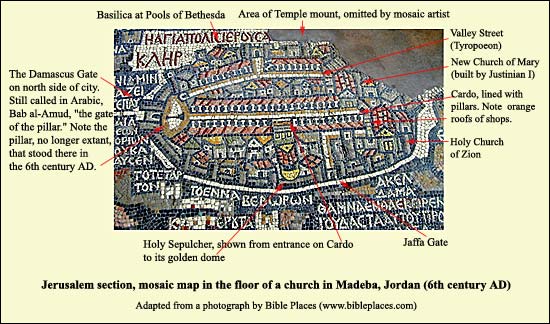
The Muslims conquered Jerusalem in 638 AD, led by the Caliph Umar. The text of the Covenant of Umar states that the city will be closed to the Jews. Whatever the authenticity of this document, all other evidence indicates the contrary: the Muslims were the first to let significant numbers of Jews back into the city. (Peters,Peters, F.E. Jerusalem. Princeton: Princeton University Press, 1985.p. 186). {mospagebreak title=Logistics} Logistics for a visit to the Dome of the Rock and al-Aqsa Mosque Telephone numbers: (02) 622 6250, 622 6270 (Israeli police at site) (02) 6283313, 6272358 (Muslim Supreme Council) The whole esplanade is closed to tourists on Fridays, Saturdays and certain holidays, so one should always check by phone in advance. On other days it is open from 07:30 to 10:00 and for an hour a little after noon. Be prepared to wait a long time on line for the security check. As of the present writing (March 2016), only Muslims are permitted inside the buildings. Arms and legs must be fully and opaquely covered, although males may wear short sleeves. Only Muslims are permitted to pray or sing on the esplanade. One is not allowed entry with anything that the police may interpret as a religious item, such as a Bible, a song book, a crucifix, pictures of religious figures, or pictures of the temple. One is not allowed entry with anything that the police may interpret as a weapon, even a pocket knife. No alcoholic beverages are allowed. No physical contact between the sexes is allowed. Inside the buildings (currently off limits to all but Muslims), one must not sit down. One should not open diagrams of the area, e.g., of the Temple. Entrance to the esplanade is free, but one must buy a ticket to enter the buildings (currently off limits). One may photograph outside the buildings, but not inside them. Before entering the Dome of the Rock or the al-Aksa mosque, one must leave shoes and all portable belongings outside. Ask a friend to guard them. During Ramadan one is not to eat or drink in the area. Rest rooms are available inside the Ablution Gate, west of and down from the Dome of the Rock. They are the oldest public rest rooms in existence, built in 1194. They are well maintained. A small fee is charged (currently 5 shekels).